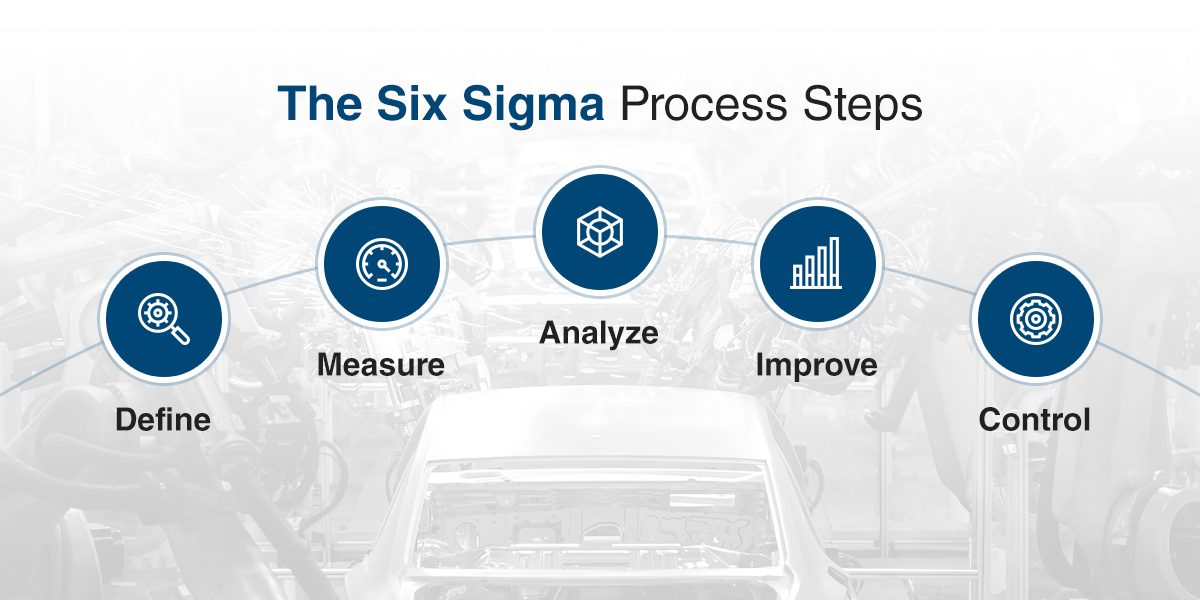In the complex and competitive world of manufacturing, where product quality and operational efficiencies are…
What is Six Sigma Methodology?
Six Sigma is one of today’s foremost process improvement methodologies. It introduces a set of standards for organizations to follow, with the ultimate goal of trimming operational waste and redundancy and therefore eliminating errors, defects and waste.
How did Six Sigma Methodology evolve to become one of the manufacturing industry’s most prominent process improvements? And does the methodology’s results match the hype?
MANTEC’s overview of Six Sigma reviews its pros, cons, certification types and implementation within the manufacturing environment. We’re establishing the foundations so you can determine which Six Sigma certification advantages your operations best — then select a partner to get you there.
More Six Sigma Resources for Manufacturers
The Core Six Sigma Process Steps (DMAIC)

The Six Sigma Methodology comprises five data-driven stages — Define, Measure, Analyze, Improve and Control (DMAIC). When fully implemented, DMAIC standardizes an organization’s problem-solving approach and shapes how it ideates new process solutions.
1. Define
The “Define” stage seeks to identify all the pertinent information necessary to break down a project, problem or process into tangible, actionable terms. It emphasizes the concrete, grounding process improvements in actual, quantifiable and qualifiable information rather than abstract goals.
Examples of terms in the Define stage include:
- Project scope charter, including budget, focus and driving motivation
- Voice of customer (VoC) research
- Value stream maps
- Project timeline
2. Measure
In the “Measure” phase, organizations assess where current process capabilities are. While they understand they need to make improvements and have listed those improvements concretely in the Define phase, they cannot go about tweaking and tailoring changes until they have a data-backed baseline.
In other words, the Measure phase initiates two activities:
- Measure the current process or activity
- Use those current data sets to establish a process capability baseline, which process improvement data will be compared to
3. Analyze
The “Analyze” phase examines the data amassed during the Measure stage to isolate the exact root causes of process inefficiencies, defects and discrepancies. In short, it extracts meaning from your data. Insights gleaned from Analyzation begin scaffolding the tangible process improvements for your team or organization to implement.
Organizations can move beyond the Analyze phase once they’ve conducted the following:
- Pareto charts and similar Six-Sigma approved data maps tracking the frequency of an issue
- Potential capability (Cp) and actual capability (Cpk) calculations
- A formal root cause analysis
4. Improve
The “Improve” initiates formal action plans meant to solve the target root problems gleaned from your Analyzations. Organizations directly address what they’ve identified as problem root causes, typically deploying a Design of Experiment plan to isolate different variables and co-factors until the true obstacle is found.
5. Control
In the final phase, “Control,” Six Sigma teams create a control plan and deploy your new standardized process. The control plan outlines improved daily workflows, which result in critical business process variables abiding by accepted quality control variances.
Each of these five phases creates a repeatable template to improve your business’ process capabilities. When the five stages are fully implemented, organizations can measure both the effectiveness and efficiency of critical manufacturing business processes. Measurements are tracked in a control chart, lending you quantifiable, comparable process-control data that leverage a competitive advantage.
What Are the Benefits of the Six Sigma Process?

The Six Sigma methodology in the manufacturing industry carries numerous benefits, each quantifiable and backed by charted growth.
1. Bolstered Productivity
Most manufacturing environments use a few key variables to measure productivity. From input figures and output units to times to market, cost-benefit ratios and more, there’s a long list of star players on a manufacturer’s productivity benchmark roster. Nearly every industrial and manufacturing operation these days searches for ways to improve these metrics, reducing overhead or lead times without sacrificing product quality or brand reputation.
Six Sigma presents a quantifiable, actionable template to do so. Through its data measurements and analysis, organizations target bottlenecks, redundancies and error-prone processes, ultimately unlocking that Goldilocks balance between producing more in less time.
2. Increased Throughput
Six Sigma’s philosophy of root cause identification and elimination is the ideal complement to a manufacturer looking to improve throughput rates.
Using precise data, you target exact production areas, from processing times or inspections to unit movement, queuing and warehousing. Further domain-specific data analyses then allow you to make additional micro tweaks and changes. No more enacting new or revised workflows via trial and error. Raw materials and complete units alike move swiftly through the production cycle, with the throughput times to prove it.
3. Improved Quality
Six Sigma doesn’t replace the operations and workflows you perform. It aims to improve what you’re already doing, tweaking tactical adjustments here and there to reduce mistakes and eliminate redundancies. These are inevitable in the manufacturing industry — but not irreversible. The results are a throughput process that produces end-to-end higher quality goods more consistently, without upending your infrastructure or operations.
4. Reduced Incidents of Damage Control
Certified Six Sigma manufacturers have better visibility over their complete production cycle. With that knowledge comes decreased “fire drills,” — instances of major product or process defects. Six Sigma peels back the curtain on some of today’s most notorious causes of product damage in the manufacturing industry, from improperly calibrated equipment that mishandles components to complete changeover errors resulting in expensive — and cumbersome — production halts.
Managers and employees alike can focus on what they need to, with fewer ad-hoc emergencies occupying their time.
5. Leaner Operating Costs
An end-to-end efficient manufacturing operation is a less costly operation. End of story. This leaves more money in the pockets of your manufacturing company, reducing overhead and direct expenses alike and burgeoning your overall bottom line.
The Challenges of Six Sigma
Like any process improvement, Six Sigma is not without its growing pains.
1. Differing Definitions and Approaches
The guiding philosophy behind Six Sigma is the five-stage DMAIC process, which assumes every detail and activity in the manufacturing environment involves quantifiable inputs and outputs. While this isn’t misguided, it presents problems with less immediately or obviously quantifiable operations. Without proper statistical training, organizations are burdened with the task of quantifying data points seemingly in the dark.
What’s more, DMAIC is not the only approach used in Six Sigma theory. Others have fine-tuned similar but separate process improvement methodologies for manufacturers to adopt depending on operational efficiency goals.
2. Highly Statistical
Six Sigma relies on a diverse set of statistical tools to identify and validate a process’ root problem. Using the DMAIC model alone, teams may conduct any of the following quantitative calculation techniques:
- Control chart creation
- Statistical process control (SPC)
- Potential capability (Cp) and actual capability (Cpk) calculations
- Hypothesis testing
- Process mapping
- Failure mode and effect analysis
- Value stream mapping
- VoC research
- And more
At the very least, organizations committing to Six Sigma improvements will need a statistics or data analytics expert to guide, if not spearhead, these imperative toolsets.
3. Wider Organizational Disconnect
Leaders in the wider organization may not have the technical fluency needed for Six Sigma buy-in and continued support. This leadership disconnect is also likely to spur misappropriated resources, with Six Sigma efforts not receiving proper time commitments, budgets, dedicated personnel and other resources needed to guide it to full process-control validation.
These challenges shouldn’t discourage your manufacturing company from researching Six Sigma consulting and training opportunities. With the proper commitment and org-wide communication, a Six Sigma methodology can be engrained into your manufacturing organization’s end-to-end workflows.
Need Help Overcoming Challenges?
Six Sigma Certificate Types

There are three tiers of official Six Sigma certification. Through training, an organization progresses to the next level of certification. Movement up the accreditation pipeline signals an organization’s proven mastery of Six Sigma concepts, as well as its ability to incorporate those concepts into daily workflows without reverting back to “old,” less efficient ways.
- Six Sigma Yellow Belt: The Yellow Belt is the foundational tier of Six Sigma’s three methodologies. Yellow Belt training provides a topical overview of Six Sigma terms and applications, including managements’ roles, major statistical tools and typically the DMAIC model. Most importantly, the Yellow Belt Six Sigma certificate signifies an organization’s understanding of Root Cause Problem Solving, using appropriate data-gathering tools and techniques to reduce process variation.
- Six Sigma Green Belt: Six Sigma’s Green Belt is the intermediary accreditation available to manufacturing organizations. At this level, participants undergo in-depth tutorials on statistical tools and data modeling. Green Belt-certified professionals can select, initiate and analyze the exact statistical models best fit to solve a project or problem variation, fluent in proper data collection, calculations, representation, interpretation and, ultimately, control chart implementation.
- Six Sigma Black Belt: The Black Belt is the third and final tier of Six Sigma certification. It is the methodology’s most advanced accreditation. Industry professionals holding a Black Belt certificate are considered Six Sigma project leaders or managers, independently able to implement a Six Sigma template across an end-to-end process improvement. They are fluent in Six Sigma terminology, statistical tools and philosophical application and can coach and mentor team members at or below the Yellow and Green Belt levels.
The History of Six Sigma
Six Sigma’s origins span nearly four decades. Across those years, its guiding tenets have always been the same – through experimentation, organizations unlock new levels of profitability and success by fine-tuning streamlined, standardized and repeatable production processes.
Those standardized processes are further complemented by robust data analysis. Systems are continually measured and analyzed to maintain efficiency and assure repetition, without old processes, activities and workflows creeping back in.
1. Which Was the First Company to Implement Six Sigma?
While variations of Six Sigma methods existed as early as the 1920s — most notably at Ford automobile plants in the 1920s and ’30s — telecommunications conglomerate Motorola was the first organization to officially create and use Six Sigma in the early 1980s. Prompted by increased rates of product defects, Motorola devised the management template as a way to implement tighter cost controls across its extensive electronics manufacturing branches.
The company also sought to investigate the standard industry assumption of the time, which accepted that reducing production budgets or cycle times would mean reducing the end quality of the product itself.
However, the success of its gamble paid off. Companies worldwide began taking note of the system, most notably General Electric (GE). In 1995, then GE CEO and business consultant Jack Welch introduced Six Sigma to the company’s quality control, manufacturing and business-management processes. This positioned GE as one of the first companies outside of Motorola to execute the Six Sigma methodology successfully into its organization, triggering further interest and adoption of this system.
2. In What Industries Is Six Sigma Most Prevalent?
Today, many Fortune 500 companies report integrating Six Sigma management methodologies into their organizations. The following manufacturing subfields, in particular, have adopted Six Sigma over the years to successful results:
- Automotive
- Construction
- Consumer electronics
- Energy
- Food and beverage
- General consumer goods
- Heavy machinery and industrial equipment
- Mining
- Transportation
Application of Six Sigma in Manufacturing

Six Sigma in the manufacturing industry has one guiding premise — the elimination of variation within the product lifecycle, ultimately ensuring each run aligns with an ideal production outcome.
This goal has distinct relevancy for those in manufacturing, including many of the following:
- Product superiority: Eliminating production variability consistently creates field-leading goods. The official Six Sigma template states a target goal of 3.4 defects per million chances. To most organizations, this seems an unfeasible and even impossible achievement — until they’ve fully implemented Six Sigma.
- Financial visibility: Six Sigma’s diligent DMAIC approach, among others, fine-tunes every role, responsibility and activity toward objective value measures, runs them through hypothesis tests and measures their outcomes. No stone is left unturned. This attention toward input experimentation gives heightened cost visibility, allowing organizations to execute keener calculations for a project or process’ financial returns.
- Customer delight: Six Sigma’s emphasis on Voice of Customer (VoC) research provides one of the best templates for organizations to understand the true wants, needs and opinions of their customer base. With that knowledge in hand, manufacturers can shape all products and processes to surpass customers’ expectations.
- Business stability: Six Sigma reduces business changeability. By using statistical data analysis to target and phase out previously problematic workflows, organizations objectively assure they are maximizing outputs using only the best, most researched and properly quantified inputs. The result is an organization achieving new levels of business fluidity and nimbleness, alongside tighter cost controls, smoother delivery and the greatest possible product quality.
Real-World Examples of Six Sigma
Countless organizations have seen success implementing Six Sigma policies. Here are a few notable success stories:
- Microsoft: Six Sigma drove success at Microsoft by paving the way for improvements that benefited employees and consumers alike. Implementing Six Sigma increased back-end efficiency, which gave developers the support they needed to improve the user experience.
- Motorola: One of the first instances of Six Sigma’s use by a major corporation, Motorola implemented the strategy to improve product quality and drive revenue as a result.
- Boeing Airlines: Six Sigma empowered Boeing Airlines to fix an engine air fan problem. The company discovered manufacturing issues that caused harmful electrical problems.
- General Electric: Integrating Six Sigma into all operations helped GE pinpoint previously unnoticed defects that slowed production. GE’s updated strategy streamlined processes and reduced waste.
- Linde Group: This gas and engineering organization used the lean Six Sigma method to boost productivity and reduce production costs.
Tips for Implementing Six Sigma
Six Sigma has benefited numerous organizations, and it can benefit yours, too. MANTEC has tips to help your business make the most of Six Sigma implementation.
Allow Six Sigma to Influence Your Organization’s Goals Strategy
Six Sigma strategies are most effective when they permeate every aspect of your business. Team members at every level need to take the transition seriously so that it can properly take hold in the organization. Six Sigma should act as a core philosophy that focuses your organization on quality and productivity.
Establish Unity From the Top
Leadership has a crucial role in the success of your Six Sigma implementation. True improvements come when organizational leaders display a willingness to change. Leading by example will inspire more of your company to engage with the Six Sigma process.
Achieve Some Quick Victories
Transitions can be tough, so building momentum through success will boost team morale. Start with projects that middle management and senior leadership teams know team members feel passionate about. Accomplishing a goal that makes a noticeable difference in your team’s work lives will spread confidence.
Integrate Six Sigma Technology
Six Sigma and information technology (IT) thrive together. Your company can implement technology that simplifies and expedites critical processes like production and testing so there are fewer defects. Plus, IT solutions can spot defects that slip through before the product reaches the end user.
Change Behaviors, Not Just Tools
Successful Six Sigma implementation requires an ideological shift. Everyone in your organization from the top down will need to change their behaviors to address problems once and for all. You’ll see your Six Sigma tools produce improvements when individuals using the tools modify their mindset.
Six Sigma Consultations and On-Site Training From MANTEC
MANTEC provides a range of Six Sigma programs for Pennsylvania manufacturers, including courses in:
- Six Sigma Yellow Belt
- Six Sigma Green Belt
- Six Sigma Black Belt
- A3 Problem Solving
- LEAN Six Sigma company consulting
Each is tailored to be targeted, affordable and effective, working with your staff to earn the next level of certification. We particularly specialize in small and medium-sized manufacturing operations here in Pennsylvania, working with our regional partners to introduce process improvements, proper statistical data analysis tools and reduce waste within your walls, for your products.
Do you have a project that would benefit from 6 sigma certification? Contact us to see our list of course schedules and begin your Six Sigma certification in Pennsylvania today.


